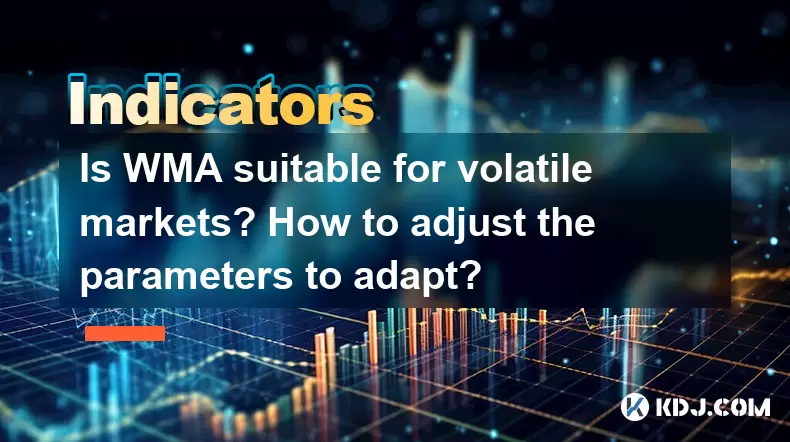-
 bitcoin
bitcoin $112195.049338 USD
2.42% -
 ethereum
ethereum $4124.915858 USD
2.81% -
 tether
tether $1.000570 USD
0.02% -
 xrp
xrp $2.861568 USD
2.25% -
 bnb
bnb $1000.346670 USD
3.04% -
 solana
solana $209.070819 USD
3.38% -
 usd-coin
usd-coin $0.999870 USD
0.02% -
 dogecoin
dogecoin $0.235379 USD
2.65% -
 tron
tron $0.335681 USD
-0.20% -
 cardano
cardano $0.803501 USD
3.38% -
 hyperliquid
hyperliquid $47.120881 USD
3.56% -
 chainlink
chainlink $21.501300 USD
3.44% -
 ethena-usde
ethena-usde $1.000571 USD
0.02% -
 avalanche
avalanche $29.793378 USD
3.62% -
 stellar
stellar $0.366964 USD
2.42%
Is WMA suitable for volatile markets? How to adjust the parameters to adapt?
WMA's responsiveness to recent price data makes it suitable for volatile crypto markets; adjust period length to capture quick movements effectively.
May 21, 2025 at 11:14 pm

Weighted Moving Average (WMA) is a popular technical indicator used by traders to analyze price trends in the cryptocurrency market. Given the inherent volatility of this market, understanding whether WMA is suitable and how to adjust its parameters to adapt to such conditions is crucial for effective trading strategies.
Understanding WMA and Volatility
WMA, or Weighted Moving Average, assigns a heavier weighting to more recent price data, making it more responsive to new price changes compared to a Simple Moving Average (SMA). This characteristic makes WMA particularly useful in volatile markets, where prices can fluctuate rapidly. Volatility in the cryptocurrency market refers to the degree of variation of trading prices over time, which can be influenced by various factors such as market sentiment, regulatory news, and macroeconomic events.
Suitability of WMA in Volatile Markets
In volatile markets, the ability to quickly identify and react to price changes is essential. WMA's responsiveness to recent price data makes it a suitable tool for traders looking to capitalize on short-term price movements. Unlike SMA, which treats all data points equally, WMA's emphasis on recent prices allows traders to get a more accurate picture of current market trends, which is particularly beneficial in environments where prices can swing dramatically within short periods.
Adjusting WMA Parameters for Volatile Markets
To effectively use WMA in volatile markets, traders need to adjust its parameters to suit the specific conditions of the market they are trading in. The primary parameter to adjust is the period length, which determines how many data points are included in the calculation of the WMA.
Shorter Period Lengths: In highly volatile markets, using a shorter period length (e.g., 5-10 periods) can help traders capture quick price movements. A shorter period length makes the WMA more sensitive to recent price changes, allowing traders to identify trends and potential reversals more quickly.
Longer Period Lengths: Conversely, in markets with moderate volatility, a longer period length (e.g., 20-50 periods) may be more appropriate. This setting smooths out the WMA, reducing the impact of short-term fluctuations and providing a clearer view of the overall trend.
Implementing WMA in Trading Strategies
To effectively implement WMA in trading strategies tailored for volatile markets, traders can follow these steps:
Choose the Right Timeframe: Depending on the level of volatility, select a timeframe that aligns with your trading strategy. For highly volatile markets, shorter timeframes like 1-minute or 5-minute charts may be more suitable.
Set Up WMA on Your Chart: Most trading platforms allow you to add WMA to your charts. Here’s how you can do it on a popular platform like TradingView:
- Open your chart and click on the 'Indicators' button.
- Search for 'WMA' and select it.
- Adjust the period length according to your strategy (e.g., 5 for short-term trading).
Analyze the WMA: Monitor the WMA line on your chart. When the price crosses above the WMA, it may indicate a potential bullish trend, while a cross below the WMA could signal a bearish trend.
Combine with Other Indicators: To enhance the effectiveness of WMA in volatile markets, consider combining it with other indicators such as the Relative Strength Index (RSI) or Bollinger Bands. This can provide additional confirmation of trends and potential reversals.
Fine-Tuning WMA for Different Cryptocurrencies
Different cryptocurrencies may exhibit varying levels of volatility, requiring traders to fine-tune their WMA settings accordingly. For instance, Bitcoin (BTC) may have different volatility patterns compared to altcoins like Ethereum (ETH) or Ripple (XRP).
Bitcoin (BTC): Given its high liquidity and widespread adoption, Bitcoin often experiences less extreme volatility compared to some altcoins. Traders might find a medium period length (e.g., 15-25 periods) suitable for WMA when trading BTC.
Altcoins: Altcoins can be more volatile due to lower liquidity and higher susceptibility to market sentiment. For these assets, traders might opt for shorter period lengths (e.g., 5-10 periods) to better capture rapid price movements.
Practical Example of WMA in a Volatile Market
Consider a scenario where a trader is monitoring the price of Ethereum (ETH) on a 5-minute chart. The market is experiencing high volatility due to a recent regulatory announcement. The trader has set up a WMA with a period length of 5 to quickly react to price changes.
Price Movement: ETH's price suddenly spikes upward due to positive news. The WMA quickly rises, confirming the bullish trend.
Trading Decision: Seeing the WMA line cross above the current price, the trader enters a long position, anticipating further upward movement.
Monitoring: As the price continues to rise, the WMA follows closely, providing real-time feedback on the trend's strength. If the price begins to fall and crosses below the WMA, the trader may consider exiting the position to lock in profits.
Adjusting WMA for Different Market Conditions
While WMA can be effective in volatile markets, it's important to adjust the parameters based on changing market conditions. For instance, if volatility decreases, traders may need to increase the period length to smooth out the WMA and reduce false signals.
Decreasing Volatility: If the market stabilizes and volatility decreases, consider increasing the period length to 10-20 periods to maintain the WMA's relevance.
Increasing Volatility: If volatility spikes, reduce the period length to 3-5 periods to stay responsive to rapid price changes.
FAQs
Q: Can WMA be used effectively with other moving averages in volatile markets?A: Yes, combining WMA with other moving averages like the Exponential Moving Average (EMA) or the Simple Moving Average (SMA) can provide a more comprehensive view of market trends. For example, using a short-term WMA alongside a longer-term EMA can help traders identify both short-term movements and longer-term trends, enhancing their ability to navigate volatile markets.
Q: How does WMA compare to other indicators like the MACD in volatile markets?A: WMA and the Moving Average Convergence Divergence (MACD) serve different purposes. WMA focuses on the trend direction by weighting recent prices more heavily, making it more suitable for identifying short-term trends in volatile markets. MACD, on the other hand, measures the relationship between two moving averages and can be used to identify potential trend reversals. Both can be effective in volatile markets, but WMA might be more responsive to quick price changes.
Q: Is WMA more suitable for day trading or swing trading in volatile markets?A: WMA is particularly well-suited for day trading in volatile markets due to its sensitivity to recent price data. Day traders can use shorter period lengths to capture rapid price movements and make quick trading decisions. For swing trading, where the focus is on capturing larger price swings over a few days to weeks, a longer period length may be more appropriate to smooth out short-term volatility and focus on the broader trend.
Q: How can traders avoid false signals when using WMA in highly volatile markets?A: To avoid false signals, traders can use additional confirmation tools alongside WMA. For instance, combining WMA with volume indicators or other trend confirmation tools like the RSI can help validate signals. Additionally, setting a higher period length can reduce the frequency of false signals, though it may also delay the identification of genuine trends.
Disclaimer:info@kdj.com
The information provided is not trading advice. kdj.com does not assume any responsibility for any investments made based on the information provided in this article. Cryptocurrencies are highly volatile and it is highly recommended that you invest with caution after thorough research!
If you believe that the content used on this website infringes your copyright, please contact us immediately (info@kdj.com) and we will delete it promptly.
- Solana: Institutions' Growing Confidence Signals a Bullish Future
- 2025-09-29 17:05:16
- PumpFun (PUMP) Price in October: Will the Memecoin Momentum Continue?
- 2025-09-29 16:25:14
- Cloud Mining, High-Yield Contracts, and Market Volatility: A New Yorker's Take
- 2025-09-29 17:05:16
- Royal Mint Error Coins: What's the Sell Price?
- 2025-09-29 16:25:14
- BABY Token Inflation and Co-Staking: A New Era for Babylon
- 2025-09-29 17:10:01
- Dogecoin, ETFs, and Memecoins: Navigating the Hype in the Wild World of Crypto
- 2025-09-29 17:10:01
Related knowledge

What is a tower bottom candlestick pattern? Does it have a high success rate?
Sep 22,2025 at 07:18am
Tower Bottom Candlestick Pattern Explained1. The tower bottom candlestick pattern is a reversal formation that typically appears at the end of a downt...

What is a black hole pattern in the MACD indicator? Is it a cause for concern?
Sep 21,2025 at 06:54pm
Bitcoin's Role in Decentralized Finance1. Bitcoin remains the cornerstone of decentralized finance, serving as a benchmark for value and security acro...

How can I use the psychological line (PSY) to determine market sentiment?
Sep 17,2025 at 02:19pm
Understanding the Psychological Line (PSY) in Cryptocurrency TradingThe Psychological Line, commonly referred to as PSY, is a momentum oscillator used...

How can I determine if a double top pattern has officially formed?
Sep 21,2025 at 03:18am
Understanding the Structure of a Double Top Pattern1. A double top pattern consists of two distinct peaks that reach approximately the same price leve...

What is the Golden Valley pattern on the moving average? Is it better than the Silver Valley pattern?
Sep 21,2025 at 02:54pm
Understanding the Golden Valley Pattern in Moving Averages1. The Golden Valley pattern is a technical formation observed in cryptocurrency price chart...

What does a death cross of the RSI in the strong zone (above 50) mean?
Sep 17,2025 at 10:54pm
Understanding the Death Cross in RSI Context1. The term 'death cross' is traditionally associated with moving averages, where a short-term average cro...

What is a tower bottom candlestick pattern? Does it have a high success rate?
Sep 22,2025 at 07:18am
Tower Bottom Candlestick Pattern Explained1. The tower bottom candlestick pattern is a reversal formation that typically appears at the end of a downt...

What is a black hole pattern in the MACD indicator? Is it a cause for concern?
Sep 21,2025 at 06:54pm
Bitcoin's Role in Decentralized Finance1. Bitcoin remains the cornerstone of decentralized finance, serving as a benchmark for value and security acro...

How can I use the psychological line (PSY) to determine market sentiment?
Sep 17,2025 at 02:19pm
Understanding the Psychological Line (PSY) in Cryptocurrency TradingThe Psychological Line, commonly referred to as PSY, is a momentum oscillator used...

How can I determine if a double top pattern has officially formed?
Sep 21,2025 at 03:18am
Understanding the Structure of a Double Top Pattern1. A double top pattern consists of two distinct peaks that reach approximately the same price leve...

What is the Golden Valley pattern on the moving average? Is it better than the Silver Valley pattern?
Sep 21,2025 at 02:54pm
Understanding the Golden Valley Pattern in Moving Averages1. The Golden Valley pattern is a technical formation observed in cryptocurrency price chart...

What does a death cross of the RSI in the strong zone (above 50) mean?
Sep 17,2025 at 10:54pm
Understanding the Death Cross in RSI Context1. The term 'death cross' is traditionally associated with moving averages, where a short-term average cro...
See all articles










































































